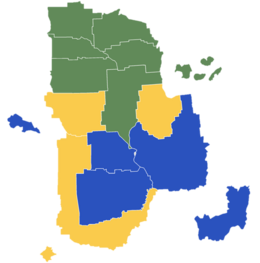Arabin Senate
Arabin Senate | |
|---|---|
| 92nd Arabin Congress | |
| Type | |
| Type | of the Arabin Congress |
Term limits | None |
| History | |
| Founded | January 10, 1839 |
New session started | January 5, 2021 |
| Leadership | |
Vice President of the Senate | Poppy Smith (D) since January 8, 2015 |
Majority Leader | Mary Nichols (D) since January 8, 2017 |
Minority Leader | Lucien Orton (R) since January 8, 2015 |
| Structure | |
| Seats | 32 17 (or 16 plus the Vice President for a majority) 19 for a 3/5 majority 21 for a 2/3 majority |
 | |
Political groups | Majority (17)
Minority (15) |
Length of term | 6 years |
| Elections | |
| Plurality | |
Last election | December 5, 2020 (11 seats) |
Next election | December 3, 2022 (11 seats + 1 special election[1]) |
| Meeting place | |
| Arabin Capitol Building, District of Arabi | |
The Arabin Senate is the upper chamber of the Arabin Congress, which along with the Arabin House of Representatives—the lower chamber—comprises the legislature of Arabi. The Senate chamber is located in the south wing of the Capitol Building, in the District.
The composition and powers of the Senate are established by Article One of the Arabin Constitution. The Senate is composed of senators, each of whom represents a single state in its entirety. Each state, regardless of its population size, is equally represented by two senators who serve staggered terms of six years. There being at present 16 states in the country, there are currently 32 senators. From 1838 to 1878, senators were appointed by legislatures of the states they represented; they are now elected by popular vote following the ratification of Tenth Amendment in 1878.
As the upper chamber of Congress, the Senate has several powers of 'advice and consent' which are unique to it. These include the approval of treaties, and the confirmation of Cabinet secretaries, Supreme Court justices, federal judges, flag officers, regulatory officials, ambassadors, other federal executive officials, and other federal uniformed officers. In addition to these, in cases wherein no candidate receives a majority of electors for vice president, the duty falls to the Senate to elect one of the top two recipients of electors for that office. Furthermore, the Senate has the responsibility of conducting the trials of those impeached by the House.
History
Membership
Qualifications
Article 1, Section 3, Clause 3, sets the following qualifications for senators: (1) must be thirty years of age; (2) must be a citizen of Arabi for seven years; (3) must be a resident within the state they reside. The age limit in the Senate was decided by the authors of the constitution because of what age they considered for an adult to be "fully mature." Over the years several members of Congress has tried to raise or lower the age limit no to avail.
Elections and term
Senate elections occur every two years during midterm elections or presidential elections. Senators are elected to six-year terms, there are no term limits. There are currently 32 seats in the Senate. Senators are split into 3 class with one-third (Class 1, 2, or 3) of senate seats are up for re-election every two years. Throughout the Senate's history there have many attempts to place term limits on senators. In 1902 an amendment was passed in Congress to limit Senators to two terms and Representatives to 6 terms for a total of 12 years in each chamber. The amendment failed to recieve three-fourths of votes in favor from the states legistlatures. Seven states voted to ratify the amendment while eight rejected it.
Notes
- ↑ Robert Stephens vacated his Senate seat on October 1, 2021 to become the 33rd Vice President. A special election will be held in 2022 fill the remainder of his term.
